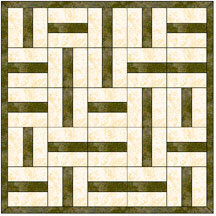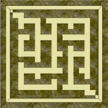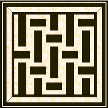A-MAZE-ingly Easy |
|
||
 |
 |
 |
|
| "Rail Fence" Maze | "T-Block" Maze | "Sashing" Maze | |
Mazes have a long an honorable history. From the stories of ancient Greece where the bull-man Minotaur awaited his unfortunate victims in the center of a maze, to the Victorian hedge-walled garden maze with an elevated viewing area where others would watch your confusion, to a laboratory learning maze for rats, to the modern "cornfield" maze, to a child's book of easy mazes, their fascination remains alive.
Designing a real maze can be bewilderingly complex. For the quilter, however, it can be a-maze-ingly easy. Your maze quilt may become anything from a child's fantasy playground to a bold graphic wall hanging.
Planning a maze
First you need to "think maze". There are as many approaches to designing a maze as there are people to design them. Like an optical illusion, how you go about designing a maze depends on where your focus is.
You can think of a maze as laid out like a road system with your background fabric as the scenery. Your focus is on the road. Every time there is an intersection, you have a decision to make. One road may be a dead end. Another may lead to a dump. You may have to detour because a bridge is out, and wander for miles before reaching your destination. A road maze is never the quickest way home.
As a game maze, you may make some stops, but you have to travel on the road. You may think you are going in circles, with many false paths, but the path is unbroken from stop to start.
You can also think of a maze as a series of "rooms" or "hallways" through which you wander. These spaces are outlined by walls, fence or other barriers, and you pass through gaps or doorways into another space. (What were "roads" in the previous maze have become walls and no longer have to be continuous lines.) A cave system, with its branching or intersecting rooms and passageways, would be fairly comparable to a room maze.
At this point I would recommend that you spend a bit of time just playing with maze design (without worrying about quilt design.) These exercises use the kind of thinking skills you will need when planning your maze quilt layout. Just be warned: they can be addictive!
The procedure for designing either a road or a room maze is roughly the same, but there are a variety of starting points for both. In this class we will explore three methods of designing a maze quilt. You will have the patterns and design guides to play with for all three, but you may make one or more, as you choose. Let's start with the simplest.
| Rail Fence Maze: Lesson 2 This is a "room" maze, or more accurately, perhaps, a "hallway" maze. The dark strips of the easy-to-make Rail Fence block make walls, dividing the quilt into paths or halls. Depending upon the fabrics chosen, this may be a quilt for small race cars to navigate, a roller coaster to zoom on or it may turn out to be a dramatic wall hanging. (Right) |
 |
 |
The T-Block Maze: Lesson 3 This is a "road" maze. It uses a simple, quick pieced modification of a 9-patch block. Depending on your fabrics, it can also make a graphic figure/ground illusion. (Left) |
|
The Sashing Maze: Lesson 4 This Zoo Quilt is a "room" maze. The walls and doorways are formed by pieced sashing strips surrounding plain blocks. This style is ideal for creating adventure quilts in the spirit of traditional "story" mazes. It is also great for displaying pictorial or novelty fabrics in an "I Spy" style. Sashing mazes take the most planning but are easy to sew. | 
| |
Next week: Directions for the Rail Fence maze. Even if you don't intend to make one as a maze quilt, play with the ideas a bit because the principles can be applied to arranging other one-directional blocks. | ||